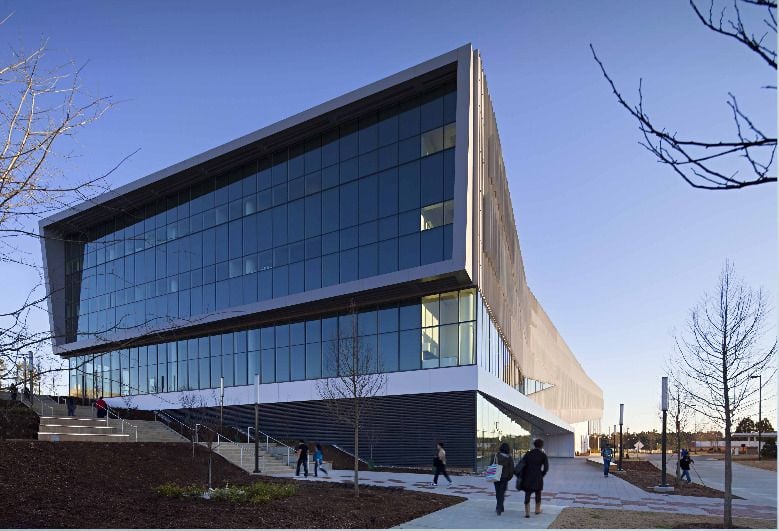Snøhetta is the name of the tallest mountain peak in Norway, literally translating from the Norwegian to “the mountain with a hood of snow.” The obscure name seems apt for the anything-but-unknown eponymous architecture firm recently picked to design an iconic new main library for Philadelphia’s Temple University.
Named for a work of nature rather than its principal designers, the New York- and Oslo-based firm Snøhetta projects an egalitarian ethos that prioritizes environment before ego, accessibility before blinding metal curvatures. Talking with Snøhetta principal Craig Dykers, the impression is confirmed. Though I have never had spoken at length with Frank Gehry — there was once a very rushed interview about a project he later aborted — I can’t help but imagine the dialogue would move differently.
On a recent Monday evening, Dykers and I chatted over the phone about how spaces can be generous and why he views design as something akin to a sheepdog.
Next City: A library you designed at North Carolina State University, Hunt Library, opened this year. Though I am aware that the contract on the Temple library hasn’t yet been signed and the design process hasn’t yet officially began, I am curious to hear any thoughts on how the NCSU design could compare to a vision for Temple.
Craig Dykers: The building was rather experimental. There is quite a lot of energy when you enter the building. Unlike in libraries of the past, where you are immediately meant to be docile and enter into a quiet space that demands that, here there is a large gaming room where students design games. It is an incredibly lively space. Whatever your feelings on video games, the point is that as soon as you enter the space you see people being active. There should be a feeling of being energized when you enter the building.
NC: In a recent conversation with The New Yorker, you compared design to the sheepdog at a party, herding guests “until, by the end of the evening, everyone at the party was in one corner.” “The dog was happy,” you said, “but the important thing was that nobody noticed.” Can you describe how, ideally, the “sheepdog” logic applied at Hunt?
Dykers: I like to watch how people use space and one of the things I was happy to see is how they used the staircase. Whenever you do a project people complain about certain things, the weather and stairs. No one likes the weather where they are and no one likes taking stairs, even though we know they force us to move and movement is healthy. Still, everyone said that no one would take them and that everyone would choose the lift. So we deliberately hid the elevators. They would look at the stairs and then head to the elevators, walk for a few feet and then stop about 10 feet away and turn back to the stairs. Talk about a sheepdog — no one telling them to take the stairs, but there was design and geometry telling them to do it. And so they did.
In terms of outdoor public space, weather is the bigger issue but you can create spaces that welcome people, activity. Some of the great outdoor spaces in New York are places where people play chess… If you can be generous and design places with people in mind, they will like them and take them as their own. That generosity is very important to us. Places should be generous.
NC: Give me an example of how a design feature in a building, in an urban library, perhaps, can be generous.
Dykers: We also designed a library in Far Rockaway, in New York. What we are doing there is creating a meaningful place where people can meet. We provided shading with the façade. It’s only a little thing but people are saying, ‘the library is keeping the rain off my face.’ Even if they don’t come in, they are interacting and benefiting from the space. We had similar design elements at the Library of Alexandria in Egypt. What we saw there was that the library became a really important place for people to gather during the Arab Spring, a place of democracy and demonstration. It became a place that people saw as their own and wanted to protect.
NC: An urban campus, like Temple’s in North Philadelphia, is obviously rife with its questions of how to best engage the public. Can you talk about tools you think may be useful for Temple and North Philadelphia?
Dykers: In the last two libraries we have done at Ryerson University and North Carolina State, the project was to create an academic window for people to see into the university. In the past, tremendous focus was put on sports stadiums as windows into the community. But increasingly, universities are realizing that libraries can also be windows, gateways into the campus and immediately connected to the academic life of the place.
NC: If you could redesign any public space in Philadelphia a la the Times Square project in New York City, what space would you choose and why?
Dykers: I don’t think I know Philadelphia well enough to say. The space in front of the train station could be quite nice. That highway there is separating you from the city. It would be nice to have something direct connecting you from the train station to the city.
Ariella Cohen is Next City’s editor-in-chief.
Follow Ariella .(JavaScript must be enabled to view this email address)
















